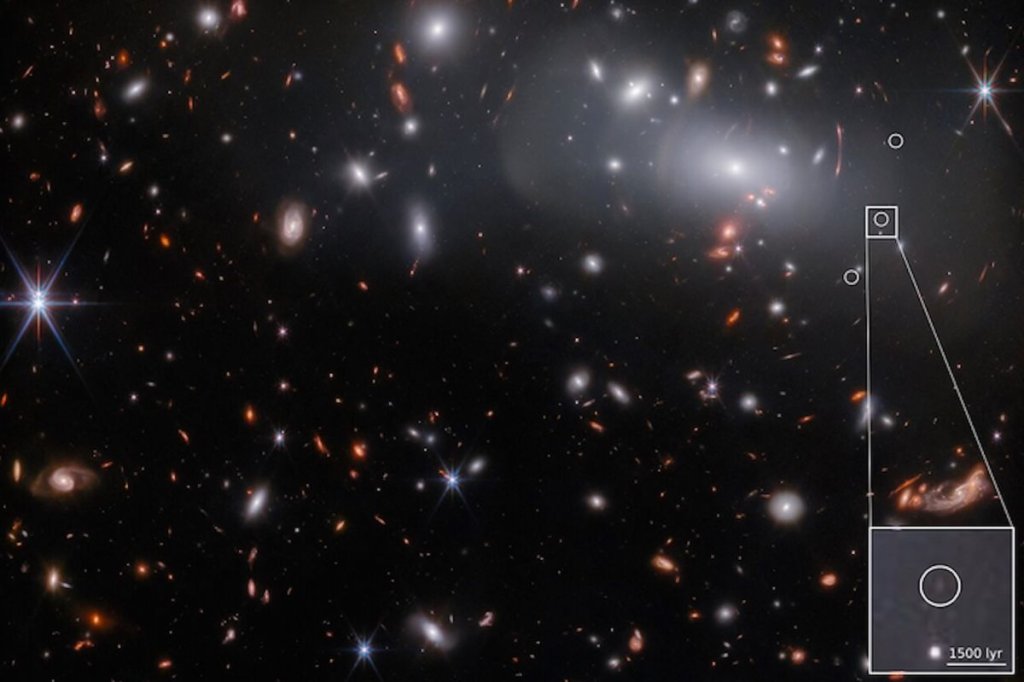
James Webb Space Telescope finds tiny early galaxy packing big star-forming punch (Image Credit: Space.com)

The James Webb Space Telescope (JWST) has discovered a tiny galaxy in the early universe that is growing rapidly as it forms stars at a tremendous rate, revealing more about the progenitors of galaxies such as our own.
The galaxy, referred to as RX J2129-z95, is seen at a redshift of 9.51. That number, which refers to the extent to which the galaxy’s light has been stretched by the expansion of the universe, means that we are seeing it as it existed just 510 million years after the Big Bang.
Because it is so distant, RX J2129-z95 is exceptionally faint. However, its light received a boost from the gravitational-lensing effect of a massive foreground galaxy cluster called RX J2129.6+0005, which is located about 2.5 billion light-years from Earth along the same line of sight. The gravity of the 150-trillion-solar-mass cluster amplified the light of RX J2129-z95, as well as splitting it into three images.
Related: 12 amazing James Webb Space Telescope discoveries
The galaxy’s redshift was confirmed by JWST‘s NIRSpec (Near-Infrared Spectrometer) instrument, which also detected strong emission from hydrogen and oxygen gas clouds within RX J2129-z95. These emission lines in the galaxy’s spectrum have revealed some of RX J2129-z95’s extraordinary properties.
For example, RX J2129-z95 is just 105.6 light-years across, which is tiny compared to the 100,000 light-year-diameter of our Milky Way galaxy or even modern dwarf galaxies that span several thousand light years. Yet despite having a volume a thousand times less than the Milky Way, RX J2129-z95’s rate of star formation is the same as our galaxy’s, meaning it is much more intense.
JWST is finding that such high star-formation rates are a fairly typical trait of galaxies in the early universe, but RX J2129-z95 is extreme even as far as high-redshift galaxies go.
“The star-formation rate is similar to other high-redshift galaxies confirmed with NIRSPec, but the radius of the galaxy is at least three times smaller than those other galaxies,” said Hayley Williams, a PhD student at the University of Minnesota who led the research, in an interview with Space.com. “This means that a ton of star formation is packed into a very tiny volume.”
The fact that all these early galaxies are small, despite their high luminosity, favors the popular model of hierarchical galaxy formation, which predicts that small galaxies formed first, before merging and growing into larger galaxies such as the Milky Way.
Williams’ team also found no evidence for an active supermassive black hole at the center of RX J2129-z95. This could be important, since RX J2129-z95 exists near the end of the “cosmic dark ages,” when radiation ionized most of the vast ocean of neutral hydrogen gas that filled the universe. One of cosmology’s biggest questions has been what led to the end of the dark ages — was it radiation from hungrily growing black holes, or from massive bouts of star formation? If RX J2129-z95 is typical, then the lack of an obvious black hole could be pointing toward radiation from plentiful hot, young stars as being the prime mover in ending the dark ages.
So far, the amount of ionizing radiation being produced by RX J2129-z95 has not been quantified. However, “if there is a substantial population of similar galaxies, then perhaps they play a key role in the ionizing photon budget,” said Williams.
More observations of galaxies at similar redshifts are required, but with a handful of very high-redshift luminous galaxies already confirmed by JWST and many more such finds likely to follow, astronomers will soon have a large sample to draw from.
Until then, “it is difficult to make conclusions about these things with such a small sample size,” said Williams.
The findings (opens in new tab) were published on April 13 in the journal Science.
Follow Keith Cooper on Twitter @21stCenturySETI (opens in new tab). Follow us on Twitter @Spacedotcom (opens in new tab) or on Facebook (opens in new tab).





